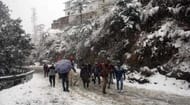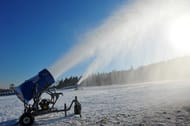“I couldn’t believe my eyes, when I saw my scores,” said Aanchal Thakur, India’s first and only medallist in alpine skiing. “Even the people over there (Turkey) could not believe it. ‘Do you even get snow in India,’ some of them asked.”
The answer to that question seems to be a resounding “no”.
The International Skiing Race, which was supposed to be held in Auli between January 15 and 21, had to be postponed to February due to the lack of snow.
What made this decision even more critical was the fact that this was set to be one of the qualifying races for the 2018 Winter Olympics, which gets underway on February 9, in Pyeongchang, South Korea.
“We planned the Auli event at such a time when we know there would be snow,” said Winter Games Federation of India general secretary Roshan Lal Thakur. “Plus, we thought that if we arranged this event ahead of the Olympics, then some of our skiers would have had the chance to qualify for the games.”
When the opportunity melted away
The cut-off date for 2018 Winter Olympics qualification was set for January 21, which also happened to be the last date for the Auli event. However, with the race being postponed, the qualification hopes of the Indian alpine skiers also faded away.

The two main Indian skiers, who were in running for Olympic qualification were the sibling duo of Himanshu and Aanchal Thakur, both of whom failed to make it to the mega event.
This has left India in an unusual situation when no alpine skiers will be representing the country at the Winter Games for the first time in 12 years.
“If the event in Auli was not postponed, I would have been able to qualify for the Winter Olympics,” said Aanchal. “The same goes for my brother (Himanshu Thakur). There were supposed to be four races, and we could have gotten our averages to lower than 140 with a good performance.”
Snow, snow going away
Although India is a predominantly known as a tropical nation, the Himalayan belt in the north does experience a good amount of snowfall in the winter. Normally regions like Manali, Auli or Gulmarg get snowfall for around three to four months every year.
Naturally, this is the time when most of the Indian skiers, especially the ones who cannot afford to go abroad, would be looking to train. However, the situation has been completely different this year.
“We have actually never faced any problems like this before. But this year, there’s no snow in Auli, Manali or Gulmarg,” said Aanchal, “It’s for the first time that there’s no snow in the winter season.”
While the sudden lack of snow in January this year is a worrying factor, the signs of its decrease have been there for some time. Aanchal explained that before, places like Manali used to get a decent amount of snowfall every winter. Now, however, that number has decreased considerably.

“Before, when my father used to ski, Manali used to get six to seven feet of snow,” she said, “Even the houses there, especially our old home in Manali, are all designed in such a way that the balcony is always above 10 feet.”
Sadly, however, the snow levels reach only up to three to four feet now.
“This obviously affects us all. The local skiers only get around three to four months to train,” said Aanchal.
This is one of the primary reason that professional skiers like Aanchal often have to go abroad in order to train for a prolonged period of time.
She may have missed out on qualifying for the Olympics this time around, but Aanchal plans to train for longer periods. In fact, she plans to go to countries in the Southern Hemisphere around July itself, in order to train in nations like Chile, Argentina and New Zealand.
A problem without a solution?
The decreasing snow levels every year is a matter of concern, but the obvious solution that comes to one’s mind is the usage of artificial snow machines, to help provide the skiers with a platform to train on regularly.
Even the machines can be rendered useless on occasions, though.
“Artificial machines can help with this, but the problem in India is that the temperatures are rarely at a desirable level,” explained Aanchal. “Even in winter, the temperature does not remain below zero for too long. We need sub-zero temperatures to create artificial snow.”

While there are machines that can generate snow that stays up to 15 degrees, they are not suited to Indian weather, as they need minus five degrees temperatures for a prolonged period of time.
She explains that the problems of the artificial snow machines increase manifold, as they are seldom used.
“The machinery that we have in place here are some seven-eight years old,” she said. “They have not been maintained properly. How can you expect them to work properly?”
A ‘global’ phenomenon
A lot has been said about global warming, and how snowcaps are melting away, to cause a rise in the sea levels. While scientists have reported rising temperatures across the globe, the world of skiing also seems to have been affected.
“Global warming could be a big factor that is affecting the sport in general. It’s not just India, but other countries are getting affected by this too,” Aanchal says.
In fact, artificial snow had to be used in Turkey where Aanchal had won India’s first medal in skiing.
“They had to put artificial snow ahead of the tournament. When they were drilling the snow to place the gates, the soil was coming out,” Aanchal said. That kind of condition causes a lot of damage to the skiis.”
Iran, where Aanchal’s brother Himanshu had got to participate in one of the last qualifying events in the sport, also did not experience snowfall in January.
However, the temperatures in these countries did drop to sub-zero levels, which allowed the tournament authorities to make proper use of the snow machines.
India’s biggest loss in 12 years
India is not a country known for its winters and winter sports are almost unheard of, except for a few pockets in the country. However, the country has managed to send athletes (although very few in number) to the Winter Olympics over the years on a consistent basis.
Luger Shiva Keshavan is one such athlete, who has landed himself in the history books, after qualifying for his sixth straight Olympics. With this, he has now equalled tennis great Leander Paes’ record of appearing in six Summer Olympics.
Skiing has also been a sport where India has had decent representation at the Winter Games. However, for the first time since 2006, the country does not have any alpine skiers in their contingent.
Is this a sign of global warming’s butterfly effect on sports? The likes of Aanchal and Roshan Lal would obviously like to opine on the contrary, especially as the former has just won India’s first international medal in the sport. However, the coming years will prove whether more skiers can maintain the standards set by the 21-year-old from Manali.
